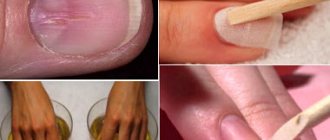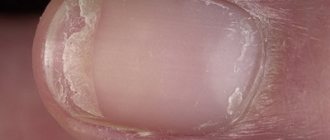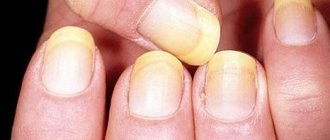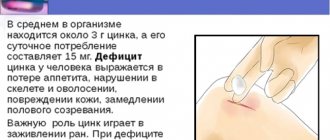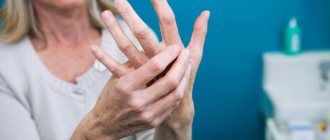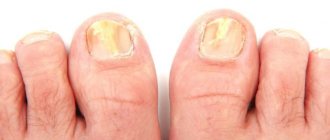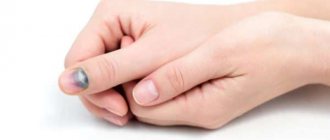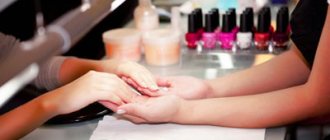Home page » Beauty » Nails
Author of the article
Svetlana Pavlikhina
Reading time: 6 minutes
AA
Toenails sometimes begin to thin, split, and curl. If no measures are taken, the pathology can not only disfigure the nail plate, but also lead to its complete loss. Both fungal and household lesions of the stratum corneum can provoke the problem.
Causes
Deformation of the plates on the lower extremities can be of the following types:
- surface curvature;
- structure delamination;
- nail loss or ingrowth into the skin;
- overgrowth of the plate with cuticle;
- hardening, compaction and increase in nail thickness.
More often the deformation is associated with:
- disease of internal organs;
- bacterial or fungal infection;
- anemia;
- hormonal imbalance;
- mechanical damage;
- improper care (lack of hygiene, abuse of varnish, frequent extensions);
- wearing the wrong shoes.
Predisposing factors include an unbalanced diet, taking certain medications that lower the immune system and disrupt the microflora, both local and general. If the disease of the nail plate is hereditary, then most often this case cannot be treated.
Infectious lesion
Bend toenails can also be caused by improper care or fungal diseases, manifested by itching between the toes and on the feet. Characterized by the presence of cracks, discomfort, and excessive sweating of the lower extremities.
First, the surface of the plate changes, then the entire structure is affected and deformed.
The list of diseases in which nails begin to deform:
- Mycosis. The causative agent is a filamentous fungus.
- Candidiasis. The disease is caused by the Candida fungus.
- Onychomycosis. Pathogen of the genus Trichophyton, Microsporum, Epidermophyton. This pathology is characterized by a change in the color of the nail and its fragility. When the purulent form is attached, a gray mass with an unpleasant odor is observed.
- Fungal epidermophytosis. The causative agents are epidermophytons.
Bacterial and fungal infections are most often associated with visiting public places and becoming infected from a sick person. But upon contact with a carrier, infection does not always occur; this is due to the strength of the immune system. Young children are more susceptible to such problems.
An infection can develop due to poor hygiene or frequent nail extensions. When the top layer of the plate is cut off, the nails become fragile and are easily susceptible to penetration by pathogenic microorganisms.
Deformation due to diseases
Deformation of the plate due to nail disease is not a common manifestation, however, folding inward can occur when:
- Koilonychia. The plates resemble the shape of a spoon. In children it can be a physiological feature and go away on its own.
- Hippocratic nails. The disease may be associated with pathological processes in the heart, liver, and lungs. Nails take on a rounded shape.
- Bird's claw. The plate thickens, bends, and curls into a tube. Usually develops after injury.
- Ptergia, when the cuticle tightens the surface of the plate, which bends inward.
Physiological reasons
Curling or ingrown toenails may be caused by wearing uncomfortable shoes. This is usually typical for models with narrow toes, when all the toes are compressed, which causes deformation of the plate.
Mechanical damage can occur both when wearing tight shoes and independently. A strong blow or a heavy object falling on the foot can cause changes in the structure of the nail.
Hormonal imbalance also increases the risk of problems.
Lack of vitamins
Sometimes deformation is associated with poor nutrition and strict diets. If the body does not receive enough necessary vitamins and nutrients, then the plates begin to thin out, break, flake, curl, bending down, up, and to the sides.
For proper growth, not only calcium is important, but also chromium, phosphorus, iron, vitamins A, C, B.
Vitamin deficiency can occur even with a balanced diet.
The main reason for this is a violation of metabolic processes, incomplete absorption of necessary substances.
This happens when the functionality of the digestive, endocrine system, or various chronic pathologies in the body is impaired.
What to do
Elimination of wavy toenails depends on the cause of the deformity. When straightening the nail plate, drug therapy will not always help. Each case is individual. L
You can’t study on your own. A doctor should determine the root cause of crooked and bent toenails.
If the nails are bent upward due to hereditary pachychonia, therapy is not prescribed. General health improvement of the body, taking vitamins, and warm baths to soften the horny plate will help.
Wavy nails occur on the feet of patients with psoriasis and eczema. It is useless to eliminate the symptoms; you need to treat the underlying ailment.
For clubfoot and flat feet, the alignment of the nail plate will be helped by wearing shoes and insoles recommended by an orthopedist.
How to straighten nails deformed by poor circulation? Regular foot massage (preferably daily) and taking medications prescribed by a specialized doctor to improve blood flow will help here.
Fungal infections of the fingers and toes are diagnosed by a dermatologist after examining the affected area for the presence of parasites.
Treatment will be aimed at eliminating the fungus that is causing concave, wavy toenails in an adult or child.
Compactions, deformations, and twisting of the horny plates due to vitamin deficiency are treated by taking vitamin complexes and a nutritious diet. Crooked toenails caused by injury cannot be treated.
You need to cut off the injured area as it grows back and wait for the nail to naturally renew itself.
Ingrown nail
This condition is typical for inflammatory and infectious pathologies of the finger. The nail can bend and pierce the skin if it is not properly cared for or if the nail trimming technique is not correct. Fungal infection or injury cannot be ruled out.
To get rid of the problem, you need to wear comfortable shoes, trim your nails carefully, and treat the fungus in a timely manner.
If the nail is deeply ingrown, then take baths with soda or herbal antibacterial mixtures.
After steaming, carefully separate the skin from the side and cut off the bent piece of the plate. If there is pus, it is necessary to relieve inflammation with Vishnevsky ointment, Levomekol.
If independent extraction is not possible, then local surgery is prescribed.
Curling the thumbnail
This is usually associated with wearing the wrong shoes. Often observed in women who prefer high-heeled models, the big toe experiences significant stress.
In an unnatural position, the tension increases even more, and the elastic plate has no room for straightening.
The problem may also be flat feet, when the position of the leg when walking is incorrect from birth.
More often the “blow” falls on the big toes, less often on the little toes. The remaining phalanges are affected only by penetration of the fungus or other painful conditions.
Treatment
Since plate deformation can have a number of causes, treatment must be comprehensive. The initial examination is carried out by a dermatologist, then after the tests a list of specialized specialists is recommended.
Basic tips, regardless of the type of disease, include:
- Normalization of nutrition.
- Maintaining hygiene rules.
- Wearing comfortable shoes.
- Preventive intake of vitamin complexes in spring and autumn.
- Strengthening the immune system.
- Compliance with work and rest schedules.
- Stabilization of emotional and hormonal levels.
Medications
Therapy is prescribed individually, taking into account the underlying cause and the patient’s condition:
- If the disease is caused by a fungus, then antifungal drugs and medications to strengthen the immune system are indicated.
- If you have vitamin deficiency, you need to balance your diet and take a vitamin course.
- For ingrown toenails, local relief of swelling and inflammation is indicated, as well as removal of the ingrown area.
If necessary, massage, hardware pedicure, laser and radio wave treatment are performed. In orthopedics, a method has been developed to straighten the plate by installing a bracket. More often it is used to correct ingrown toenails.
If an inflammatory or purulent process is observed, baths with manganese and furatsilin are indicated.
After the procedure, Levomekol and Baneocin are prescribed locally. This helps prevent the development of microorganisms and initiates tissue regeneration processes.
Traditional medicine methods
Folk remedies are based on relieving inflammation and nourishing tissues. For this, lotions and baths with string, nettle, calamus, elecampane, and St. John's wort are used.
The affected nail can be treated with the juice of Kalanchoe, celandine, onion, olive oil, sea buckthorn, and eucalyptus.
Treatment methods
Once the specialist has accurately identified the ingrown toenail, he can suggest several ways to treat it. It can be carried out both in a hospital and at home. Next, we will talk about all the available methods for treating an ingrown toenail and more.
Acrylic correction
This treatment method is more of a preventative measure to prevent the nail from growing into the skin. Correction of an ingrown nail with acrylic is carried out once every six months and is a regular extension. Acrylic lifts the corners of the nail plate, thereby preventing them from penetrating the skin. As a result, discomfort disappears and a neat pedicure appears. Acrylic has greater shrinkage, so it is better suited in this case, although the use of gel as a material for extensions is also acceptable.
Hardware pedicure
This procedure is not only for those who want to get beautiful legs. With its help you can also correct the situation with an ingrown toenail. There are two types of hardware pedicure:
- Cosmetic. This can be done by any pedicurist who knows how to operate the device.
- Medical. The technician must have a medical education and be able to install plates or staples.
For people who are predisposed to ingrown nails, periodic cosmetic pedicures are mandatory. The skin is softened with special means, and the nail plates themselves are polished with different attachments. With their help, rough skin is removed, and the ingrown part of the nail is carefully filed down.
This correction allows you to straighten the direction of nail growth. But it can only be done at the first stage, while the problem area has not yet festered.
Correction with plates
This method can also be called a medical hardware pedicure, but they usually say that this is the correction of an ingrown nail with plates. Depending on the individual characteristics of the client, plates, staples or half-staples made from various materials can be used. Their use will make sense in the first stages of the disease.
The following materials are used to correct an ingrown toenail:
- Podofix plate - made of special plastic, helps correct curled nails, instantly removes pain;
- Combiped staple - one end of it is attached at one angle of the nail, and the second is glued to the surface of the nail (helps to level the nail only from one edge);
- Oniclip plate – controls pressure on the nail, thereby preventing it from growing, can be used after nail removal;
- gold plate goldspang - made of gold-plated jewelry steel, glued to the nail in especially severe cases.
Table “General characteristics of plates and staples for correcting ingrown toenails”
Laser correction
When you want to get an excellent result quickly, while expecting the least additional damage, laser correction of an ingrown toenail comes to the rescue. True, such a procedure costs quite a lot of money.
Another attractive thing about this method is that there is no need to completely remove the affected nail - only the ingrown part is treated with the laser. But if the nail or the skin around it is inflamed, you need to heal a little first. The procedure itself is practically painless and does not take much time.
After the ingrown part of the nail is completely removed, it begins to grow more slowly, and therefore re-ingrowing occurs extremely rarely.
Laser correction of ingrown toenails has mostly positive reviews, because... After it, the finger retains its aesthetic appearance, the skin practically does not hurt or bleed, and you can return to normal life in just a few days. The full recovery period takes from one to two months and may be accompanied by unpleasant painful sensations until healing. An additional bonus to this correction is the destruction of fungal infection.
However, this method also has some contraindications:
- damage to foot tissue;
- diabetes;
- poor blood clotting.
Video “Correction of ingrown toenails with laser”
The procedure for treating an ingrown toenail with a laser is presented in the video.
Prevention
The question often arises about what to do to reduce the risk of deformation of the nail plate on the lower extremities.
For these purposes it is recommended:
- Wash your feet daily and wear clean socks.
- Trim your nails correctly.
- When visiting public places, use your own things and do not walk without shoes, especially in swimming pools and saunas.
- Strengthen immunity.
- To live an active lifestyle.
- Eat a balanced diet.
- Treat all chronic pathologies in a timely manner.
Preventive measures
To avoid having to suffer from an ingrown toenail and spend money on treatment, you need to start taking care of your fingers in advance. To do this, just follow these recommendations:
- wear shoes with low heels more often; it’s better to avoid high heels altogether;
- do not wear shoes that do not fit;
- every day you need to give your feet a rest and walk completely barefoot for a couple of hours;
- do not forget about hygiene and wash your feet with soap every day;
- try to minimize the number of injuries;
- avoid sudden changes in weight;
- learn how to cut your nails correctly;
- If you suspect an ingrown toenail, consult a doctor.
To ensure that your nails are trimmed correctly, you should do it like this:
- fingers and instruments should be well treated with an antiseptic;
- feet should also be washed with soap;
- Dry nails should not be trimmed;
- It is advisable to choose manicure scissors, but with straight ends;
- nails are not cut to the root;
- the shape should not be rounded at the corners;
- If the corners turn out to be sharp, they can be carefully processed with a nail file.
